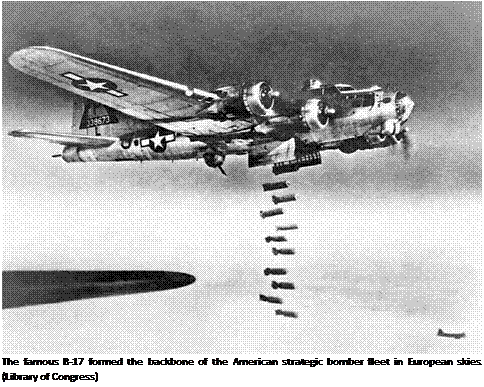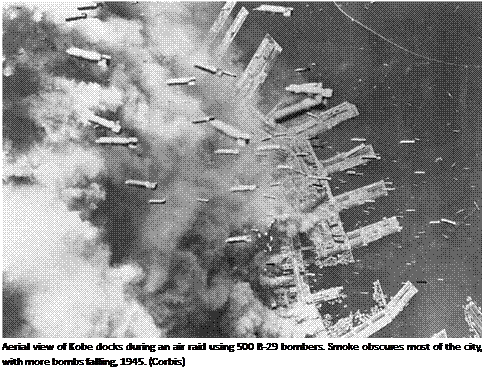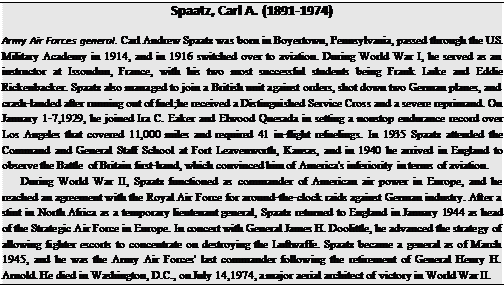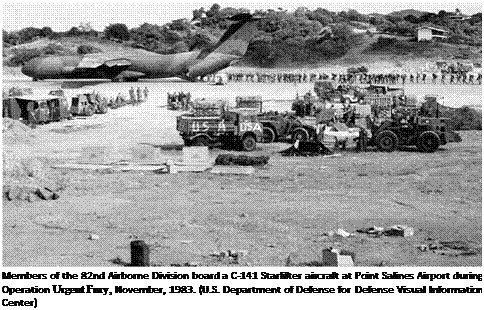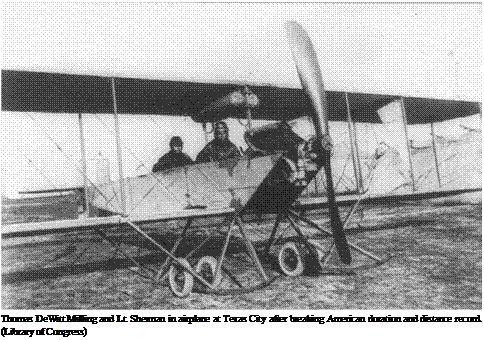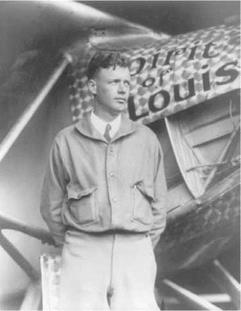JANUARY 1 In England, the Eighth Air Force redesignates its three Bomb Divisions as Air Divisions. Hundreds of sorties are also flown against German troop concentrations and communication lines, despite the bad weather.
Meanwhile, 700 heavy bombers are dispatched to strike Rhine River bridges, rail junctions, and airfields in 10 German cities. The 14 fighter groups flying escort engage 120 German interceptors over Frankfurt/Main and Hannover, claiming 17 kills.
Over Belgium, Holland, and France, the Luftwaffe launches Operation boden – PLATTE, a surprise attack on Allied forward air bases. They manage to destroy around 120 aircraft on the ground only to lose 460 to German antiaircraft crews, who assumed they were enemy formations.
JANUARY 2 Over China, troop carriers attached to the Tenth Air Force fly 546 sorties to resupply troops on the front line; amazingly, this becomes the daily operational average for the rest of the year.
In the Philippines, Far East Air Forces (FEAF) P-38s and A-20s strike Japanese targets around San Fernando Harbor while B-24s pound Clark Field and B-25s blast enemy airfields near Batangas.
JANUARY 3 Over Nagoya, Japan, 57 of 87 B-29s have been equipped with firebombs as part of a test-bombing mission. Results are inconclusive, giving the erroneous impression that Japanese fire – prevention systems are working well.
JANUARY 5 In China, Operation grubWORM, the aerial transfer of two Chinese infantry divisions, their headquarters, and all attached units, concludes. It took 1,300 transport sorties to relocate the force from Burma to the front lines, but was accomplished with the loss of only 3 aircraft.
JANUARY 7 Over northern Luzon, Philippines, the Far East Air Forces (FEAF), in concert with carrier aircraft from the Third Fleet, contributes 130 light and medium bombers to attack Japanese airfields. This is also one of the largest joint missions in the Southwest Pacific campaign.
JANUARY 9 Over the Philippines, the Far East Air Forces (FEAF) continues providing close air support at various points, especially in the Lingayen Gulf region.
Over Iwo Jima, B-24s equipped with H2X bombing equipment attack Japanese airfields near Suribachi Bay.
JANUARY 10 The Thirteen Air Force begins shifting bases of operation from New Guinea to Leyte, Philippines, to support the American offensive there.
JANUARY 11 Over Luzon, Philippines, a reconnaissance version P-51 Mustang (F-6D) piloted by Captain William A. Shomo shoots down seven Japanese aircraft while his wingman bags three; considering that reconnaissance pilots rarely engage in combat, he wins the Congressional Medal of Honor.
JANUARY 17 From Chengtu, China, the XX Bomber Command unleashes 91 B-29 heavy bombers over military targets at Shinchiku, Formosa (Taiwan). This is the last such raid mounted from Chengtu, and by March the force transfers to the Marianas to be closer to Japan. The 58th Bomb Wing, meanwhile, remains active in India and provides tactical help to British
|
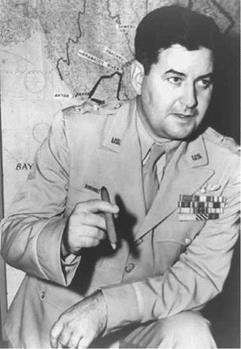
General Curtis E. LeMay orchestrated the highly successful strategic bombing campaign against Japan. (Library of Congress)
|
forces in Burma, with an occasional raid against Singapore and the East Indies.
JANUARY 20 On Guam, Major General Curtis E. LeMay takes command of the XXI Bomber Command, replacing Brigadier General Haywood S. Hansell. LeMay is expected to take revamp the largely unsatisfactory strategic bombing campaign against Japan. In India, Brigadier General Roger M. Ramey also assumes control of the XX Bomber Command.
JANUARY 22 Over Formosa (Taiwan), Fifth Air Force B-24s and P-38s mount their first air raid against Japanese targets, while other aircraft continue supporting ground operations on Luzon, Philippines.
JANUARY 24 Over Attu, Alaska, fighters
of the Eleventh Air Force down an armed Japanese Fu-Go balloon.
Iwo Jima, Bonin Islands, is the object of a bombing campaign by B-24s from the Seventh Air Force and B-29s from the XX Air Force.
B-24s attached to the Far East Air Forces (FEAF) commence a three-week bombing campaign against Japanese positions on Corregidor, Philippines.
January 25—26 Over Southeast Asia, the XX Bomber Command launches 70 B-29s heavy bombers, which sow mines in Singapore Harbor, Cam Ranh Bay, Pakchan River, and Phan Rang Bay; this is also the largest single mining operation of the entire war.
JANUARY 27 The Twentieth Air Force
completes a difficult transfer from Chengtu, China, to bases in India prior to a final move to the Marianas Islands in March.
In the Marianas, the XXI Bomber Command launches 130 B-29 heavy bombers, which strike targets in Tokyo, Japan. Five of the giant craft are lost to fighters while a further four ditch or crash-land due to mechanical failures. American gunners also claim to have shot down several enemy fighters.
JANUARY 28 Over Germany, this being the third anniversary of the Eighth Air Force’s founding, a 1,000-plane air raid is launched over selected targets. By this date it has flown 250,000 bomber and 210,000 fighter sorties, dropped 518,000 tons ofbombs, and shot down 13,000 enemy aircraft.
Transport aircraft in the China-Burma- India theater (CBI) continue averaging 500 sorties every day over the Hump (Himalayas), despite the fact that the Burma Road is reopened. The recent departure of B-29s based at Chengtu, China, allows more supplies to be available to the Tenth and Fourteenth Air Forces operating there.
JANUARY 31 Over Austria, good weather allows the Fifteenth Air Force to put over 760 B-17s and B-24s over oil refineries at Moosbierbaum and marshalling yards at Graz and Manibor. The former is struck once more by 300 bombers on the following day.
FEBRUARY 1 Over Germany, the Eighth Air Force hurls 600 heavy bombers against three airfields at Mannheim, Ludwigshafen, and Krefeld while 6 fighter groups provide escort.
FEBRUARY 3 From England, the Eighth Air Force launches the largest air raid of the war to date with 1,200 B-17s and B – 24s against targets in Berlin and Magdeburg, dropping 2,266 tons of bombs. They are escorted by over 900 escort fighters, most of which accompany them to Berlin and back.
In the Marshall Islands, B-29s of XXI Bomber Command attack industrial targets in Kobe, Japan, dropping 159 tons of bombs and 13.6 tons of incendiaries; 1,039 buildings and structures are destroyed.
FEBRUARY 4 From the Marianas, the XX Air Force launches 100 B-29 heavy bombers against targets in Kobe and Nat – susaka; nearly 100 fighters rise to oppose them, but only 1 B-29 is lost, while 35 are damaged.
FEBRUARY 5 Over Italy, the Twelfth Air Force launches 270 medium bombers against German targets in the Po Valley region; an additional 730 heavy bombers from the Fifteenth Air Force fly across the Alps to strike oil refineries at Regensburg. Both operations are escorted by far-ranging P-38 and P-51 fighters.
On Corregidor, Philippines, Japanese defenses are struck by a force of 60 B-24s from the Far East Air Forces while B-25s provide close air support for ground troops.
FEBRUARY 7 In San Diego, California, the Consolidated Vultee XP-81 prototype performs its maiden flight. This innovative design employs a turboprop engine in the nose and a turbo jet in the tail, but does not progress beyond the experimental stage.
FEBRUARY 10 Over Ota, Japan, the Nakajima aircraft factory is the target of 84 B-29s heavy bombers from the XXI Bomber Command; in the absence of fighter escorts the defenders shoot down 12 of the giant bombers.
|
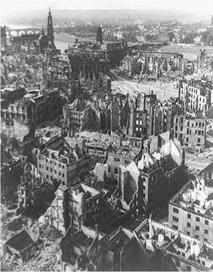
View of the wreckage of Dresden, Germany after it wasfrebombed by the Allies in 1945 during World War II. The bombing, which targeted the civilian population, was one of the most devastating aerial raids in history and was mounted in retaliation for German V-2 rocket attacks on London. Four years after the blaze, the city still appeared as a wasteland; most of its buildings were gutted, including many 1,000-year-old structures that had been completely destroyed. It took Germany decades to rebuild the city. (Library ofCongress)
|
February 12—14 Over Iwo Jima, Bonin Islands, two dozen B-29s attack Japanese antiaircraft batteries while other aircraft fly reconnaissance missions for the U. S. Navy. The island’s defenses are also struck by tactical aircraft from the Seventh Air Force, softening it up for the impending invasion.
FEBRUARY 14 Over Germany, the historic city of Dresden, having suffered from a destructive nighttime raid by the Royal Air Force, is struck again by waves of American bombers. The ensuing firestorm flattens 1,600 square acres and kills an estimated 250,000 people—more than the destruction of Hiroshima and Nagasaki combined. The attack comes as revenge for continuing V-2 attacks against London.
FEBRUARY 16 Over Corregidor, Philippines, C-47 transports drop 2,000 parachutists while tactical aircraft of the Far East Air Forces (FEAF) strike targets in and around that island in support of the invasion there.
In China, Tenth Air Force transports exceed their own record by flying 600 sorties on this day, a pace they will maintain until war’s end. Ultimately, the Air Transport Command delivers 700,000 tons of supplies at a cost of 910 aircrew.
FEBRUARY 19 On the Marianas, and in an
attempt to draw Japanese reinforcements away from Iwo Jima, the XX Air Force launches 150 B-29 heavy bombers to strike at targets in and around Tokyo, Japan; enemy fighters shoot down 6 bombers.
February 20 In Washington, D. C., Secretary of War Henry Stimson authorizes construction of a rocket testing area at White Sands, New Mexico. He had been warned that the Soviets would probably win a postwar race to build long-range ballistic missiles.
FEBRUARY 22—23 Over Western Europe, Operation clarion unfolds as fighters and bombers of the Eighth, Ninth, Twelfth, and Fifteenth Air Forces systematically destroying German transportation networks in occupied territories, including Holland, Belgium, and italy. collectively, they unleash over 9,000 aircraft to hit targets in occupied Europe over the next 24 hours. On the following day additional fighter sorties are launched to cover the Rhine River crossings.
FEBRUARY 24 Over Singapore, 105 B – 29 heavy bombers are launched by XX Bomber command against the Empire Dock area. The aircraft carry incendiary weapons, and the resulting firestorm burns 40 percent of all warehousing. This is also the last time the india-based B-29s sortie in such large numbers.
February 25 The Bell XP-83 turbojet fighter, essentially a scaled-up version of the earlier P-59 Airacomet, makes its initial flight; it is not pressed into production.
in Washington, D. c., the Pentagon hatches Project paperclip, which is designed to recruit German rocket scientists after the war.
From the Marianas islands, the XXi Bomber Command throws three bomb groups of B-29s against targets in the Tokyo area. This is the largest raid mounted by the XXi to date and the first employing incendiaries at high altitude. Over 15 square miles of the downtown section are burned out.
In Burma, B-25s of the Tenth Air Force provide close air support to British and chinese forces advancing.
February 26 In the Pacific, a B-24 Liberator carrying Lieutenant General Millard F. “Miff’ Harmon, commander of Army Air Forces, Pacific Ocean Area (AAFPAC), disappears while flying between Kwajalein and Hawaii.
FEBRUARY 27 In India, the last remaining B-29 wing begins deploying to the Marianas Islands; the movement continues until June 6.
February 28 In Washington, D. C., General Henry H. Arnold reveals the existence of the new Lockheed P-80 Shooting Star. This is the first American jet fighter to reach operational status, but it arrives too late to see service in the war.
Over Germany, the Eighth Air Force dispatches 1,104 bombers and 737 escort fighters to hit enemy transportation targets; P-51 and P-47 groups also perform low-level attacks against airfields and factories.
MARCH 1 Over Austria, 630 B-24s and B-17s from the Fifteenth Air Force bomb the oil refinery at Moosbierbaum with a 200-strong fighter escort, while 47 other P-38s make strafing runs against rail traffic around Graz and Vienna.
MARCH 4 On IwoJima, Bonin Islands, the first damaged B-29 Superfortress makes an emergency landing on the airfield while Marines continue battling for control ofthe island; before the war ends, thousands of American lives are saved by the airfield.
MARCH 6 On IwoJima, Bonin Islands, 28 P-51 Mustangs and 12 P-61 Black Widows of the Seventh Air Force arrive to begin fighter escort service for B-29 formations.
MARCH 9 In the Marianas, Lieutenant General Curtis E. LeMay of XXI Bomber Command strips his B-29s of armament and loads them with 2,000 tons of incendiaries, then launches a devastating “fire raid” against Tokyo, Japan. Nearly 16 square miles, one-fourth of the city, is destroyed, and 100,000 casualties inflicted—more than Hiroshima and Nagasaki; Japanese defenses down 14 of the giant bombers. To enhance effectiveness and reduce casualties, the raid was conducted from altitude between 4,000 feet and 9,200 feet. It is considered one of the most devastating attacks in aerial history.
MARCH 11—12 Over Germany, a force of 1,000 heavy bombers strikes the town of Essen, Germany, dropping a record total of 4,378 tons of bombs.
The XX Air Force unleashes 285 B-29 heavy bombers against industrial targets in Nagoya, Japan, dropping incendiaries at low altitude at night with devastating effect.
MARCH 13 Over central Burma, P-47s and P-38s of the Tenth Air Force continue providing close air support to the Chinese 50th Division, then driving along the Namtu River.
Osaka, Japan is struck by 274 B-29s of the Twentieth Air Force; incendiaries destroy eight square miles in the city center.
MARCH 14 Over the Balkans, the Fifteenth and Twelfth Air Forces dispatch heavy bombers to Hungary and Yugoslavia to assist the advancing Red Army; P-38s and P-51s also attack targets in Austria.
MARCH 16 Over Kobe, Japan, 300 B-29 heavy bombers belonging to XXI Bomber Command firebomb industrial targets. This is the largest raid mounted by the XX Air Force and the 2,300 tons of ordnance delivered burns down one-fifth of the city.
MARCH 18 Over Germany, the Eighth Air Force launches 1,250 heavy bombers and 670 fighters against Berlin’s transportation network, dropping 3,000 tons in the process; this is also the largest daylight air raid of the entire war.
Over Nagoya, Japan, the XXI Bomber Command hurls 300 B-29 heavy bombers against industrial targets, again flown from low altitude with devastating effect.
MARCH 21 Over Reno, Nevada, a P-63
Kingcobra shoots down a Japanese Fu- Go balloon that had drifted; the fighter refueled in order to reach the target area.
Over Rutland, Germany, a P-51 Mustang flown by Lieutenant John Kirk espies a German Me-262 jetfighter as it dives through a B-17 formation. Kirk kicks his wing over and pursues, disabling his adversary and making him bail out.
MARCH 24 Across Wesel, Germany, Operation plunder-varsity unfolds as 1,000 heavy bombers from the Eighth and Ninth Air Forces strike at rail yards, flak positions, and communications systems in support of the Rhine River crossings.
To facilitate the Allied crossing of the Rhine River, 2,000 transports drop two airborne divisions under Major General Matthew Ridgway near Wesel, Germany; 50 aircraft and 11 gliders are destroyed.
Over Germany, 150 heavy bombers from the Fifteenth Air Force attack Berlin, and drop 150 tons of bombs for the first time.
MARCH 27—28 One hundred B-29 heavy bombers depart the Marianas on their first mine-laying mission in the shi – monoseki strait between Honshu and Kyushu, Japan. Simultaneously, another 150 B-29s strike targets on Okinawa, Ryukyu Islands, which is slated for a major invasion.
MARCH 29—30 In India, XX Bomber Command launches it final mission when 24 B-29s attack oil fields on Bukum Field, Singapore, at night.
MARCH 31 Over Omura and Tachiari, Japan, 137 B-29 heavy bombers of XX Bomb Group strike industrial targets at as a diversion for the upcoming invasion of Okinawa.
April At the Aberdeen Proving Ground, Maryland, Dr. Theodore von Karman begins testing the concept of swept-back wings in a supersonic wind tunnel for the first time.
APRIL 1 Over Burma, Tenth Air Force B-25s attackJapanese rear areas and lines of communication while transports fly 478 sorties as the British 36th Division pushes down the railroad from Mandalay to Rangoon.
April 1—13 At Fort Bliss, Texas, JPL technicians test launch 17 Private F Rockets within the Hueco Range.
APRIL 2 Over Japan, the XX Air Force unleashes a large force of B-29 heavy bombers that mine waters around Kure and Hiroshima harbors, and also bomb the Nakajima aircraft factory near Tokyo.
April 4 In Burma, a YR-4 helicopter of the Air Jungle Rescue Detachment, Tenth Air Force, retrieves a PT-19 pilot down in the jungle.
APRIL 4—11 Over Germany, the Eighth Air Force unleashes 1,000 heavy bombers at industrial, transportation, and communication targets in several concerted attacks. The Nazi national infrastructure is eroding from the constant bombardment.
APRIL 7 At IwoJima, the XX Air Force is finally able to dispatch 91 P-51 Mustangs as fighter escorts on a raid by 280 B-29s against the Japanese mainland. The fighters claim to shoot down 21 opposing aircraft.
APRIL 10 Over Germany, a force of 50 German Me-262 jet fighters shoot down 10 American bombers near Berlin; this is the largest single loss to enemy jets during the war. Conversely, turret gunners and fighter escorts claim to have downed 20 German jets.
APRIL 12 Over Koriyama, Japan, Staff Sergeant Henry E. Erwin picks up a phosphorous smoke flare that had backfired into his B-29 and tosses it out the navigator’s window. He suffers severe third-degree burns, but survives and wins a Congressional Medal of Honor; he is one of only four enlisted airmen so honored.
April 13 Over the Aleutian Islands, Alaska, P-38s and P-40s of the Eleventh Air Force intercept and shoot down nine explosive Fu-Go balloons.
Over Japan, a night raid by 330 B-29 heavy bombers belonging to the XX Air Force strikes industrial targets around Tokyo.
APRIL 15 Over Germany, 850 bombers from the Eighth Air Force drop napalm weapons on German fortifications and other targets as an experiment. However, these weapons prove ineffective delivered from high altitude and the attempt is discontinued.
In northern Italy, the Fifteenth Air Force dispatches 830 B-17s and B-24s against German supply and communication targets amply escorted by P-38s. Other fighters provide close air support for units of the Fifth Army and they continue advancing. The 1,412 sorties executed and tons of bombs dropped in this 24-hour period are a record for the Fifteenth.
Over Japan, the Japanese cities of Tokyo and Kawasaki are struck by 300 B-29 heavy bombers during the night.
In Los Angeles, California, the North American XF-82 Twin Mustang prototype flies for the first time.
APRIL 16 From IwoJima, P-51 Mustangs attack ground targets on the Japanese mainland for the first time. They are guided to and from Kanoya by a B-29 accompanying them for that purpose.
April 17—May 11 Bombing priorities of the XX Air Force are shifted from strategic targets on the mainland to tactical airfields on Kyushu and Shikoku, from which waves of kamikaze attacks are launched against the American fleet off Okinawa.
April 21—26 In Italy, A-20s and B-26s from the Twelfth Air Force maul German units retreating up through the Po Valley, dropping bridge spans and destroying 1,000 vehicles. These attacks severely infringe upon the enemy’s ability to retreat.
APRIL 24—25 Over Germany, a P-47 flown by Lieutenant Raymond L. Knight accounts for 14 aircraft during strafing attacks at numerous aerodromes. When Knight’s own aircraft is damaged by flak on the second day of attacks, he refuses to abandon his wingman and crashes into a mountainside; he wins a posthumous Congressional Medal of Honor.
April 25 Eighth Air Force B-17s and B-24s hit armament works at Pilsen – Skoda, Czechoslovakia, and Traunstein, Germany; this is the last time they reduce industrial targets to rubble.
APRIL 26 Over Germany, Eighth Air Force fighters sweep the skies clean of enemy fighters as they raid Luftwaffe installations; a record 74 German aircraft are brought down in one day.
April 27 The authorized strength of bomber groups is reduced from 68 to 48 planes, while fighter groups shrink from 96 to 75 machines. This is the first step towards postwar demobilization.
May 1 Over Austria, B-17s of the Fifteenth Air Force ignore poor flying conditions and strike marshalling yards at Salzburg, Austria. They are escorted, as usual, by swarms ofP-51s and P-38s. This is also the final sortie by the Fifteenth Air Force during the war.
In Chungking, China, Lieutenant General George E. Stratemeyer assumes command of the Tenth and Fourteenth Air Forces as head of Army Air Forces China Theater, and he directs medium bombers and fighters to interdict and harass Japanese ground units as they withdraw from southern China.
May 1—7 Over the Netherlands, Operation chowhound unfolds as 400 Eighth Air Force bombers deliver 8,000 tons of food to starving citizens in the Netherlands. An agreement had been reached with the Germans to proceed without interference.
May 2 In Germany, several missile engineers, including Wernher von Braun, turn themselves over to the Americans near the Austrian border. Many are secretly relocated to Fort Bliss, Texas, to facilitate the transfer of V-2 technology to the United States. This clandestine move is essential seeing how the Red Army has occupied the German rocket test grounds at Peene – munde. During the war, the Germans fired off an estimated 20,000 V weapons, including 2,700 V-2 weapons against England and Western Europe.
May 3 Over Czechoslovakia, the 9th Bombardment Division makes its final raid when 132 A-26 Invaders strike the Stod ammunition plant.
Once Rangoon, Burma, is recaptured by Allied forces, the Tenth Air Force disengages and concentrates its assets at Piar – doba, India. Only a single P-38 squadron remains behind to patrol and protect the Burma Road into southern China.
May 8 Over Western Europe, all combat missions halt, although the Twelfth Air Force continues flying evacuation and supply missions. Aircraft of the Ninth Air Force also make “demonstration missions” over previously hostile target areas and liberated concentration camps.
May 9 In Europe, the Air Tactical Command (ATC) commences Projects green and white to relocate personnel and equipment, respectively, back to the United States.
May 10 In England, Lieutenant General James H. Doolittle departs the Eighth Air Force and is reassigned to Army Air Forces Headquarters in Washington, D. C.; his replacement is Major General William E. Kepner.
Over Japan, a force ofB-24s from the Eleventh Air Force successfully raids enemy shipping at Kataoka naval base, sinking several vessels. A force of 16 B-25s based on Attu, Aleutian Islands, also attacks Japanese vessels within their grasp.
May 14 Over Nagoya, Japan, the XX Air Force launches 472 B-29 heavy bombers from four complete bomb groups (58th, 73rd, 313th, and 314th) against industrial targets; 11 aircraft are lost.
May 16 Over Luzon, Philippines, 100 P-38s from the Far East Air Forces (FEAF) make the largest napalm attack of the entire war by striking Japanese targets in the Ipo Dam area.
May 17 478 B-29 heavy bombers strike southern Nagoya, Japan, in the predawn darkness.
May 18 On Tinian, the advanced echelon of the 509th Composite Group deploys and begins setting up for operations. Their purpose is to drop atomic bombs on Japan ifthe government refuses to surrender.
May 19 Hamamatsu, Japan, succumbs to 272 B-29 heavy bombers belonging to the XX Air Force.
May 23—24 Over Japan, the XX Air Force dispatches 562 B-29 heavy bombers against industrial targets on the west side of Tokyo harbor. This is also the largest single B-29 raid of the war; 17 bombers are lost.
May 25 Wartime production of American military aircraft is slashed by 30 percent as total victory approaches.
Tokyo, Japan, is raided again by 464 B – 29 heavy bombers of the XX Air Force, and 26 aircraft go down; this is the largest single loss suffered by B-29s during the war. Meanwhile, the VII Fighter Command on Iwo Jima is assigned to the XX Air Force.
May 29 Over Japan, the XX Air Force resumes firebombing attacks by dispatching 454 B-29 heavy bombers against targets in Yokohama, Japan; nine square miles of the downtown section are completely destroyed. The mission is escorted by 190 P-51s from VII Fighter Command on Iwo Jima; stiff resistance claims 7 bombers and 3 fighters.
May 31 The Army Air Forces receives the last models of the 18,188 B-24 Liberators constructed during World War II. This is the most numerous American warplane ever built, and several hundred also serve in the Navy as PB4Y Privateers.
June 1 Osaka, Japan, is the target of 458 B-29 heavy bombers of the XX Air Force, of which 10 are shot down. The escort of 148 fighters from VII Fighter Command is disrupted by heavy turbulence and only a handful accompany the bombers; 27 are lost through collisions.
Over China, six B-25s from the Fourteenth Air Force strike the Sinsiang rail yards while four B-25s and four P-47s attack the bridge north of Linmingkuan.
June 5 Over Japan, the XX Air Force launches 473 B-29 heavy bombers loaded
with incendiaries against targets in Kobe, and four square miles of the city is reduced to ashes; 11 bombers are shot down.
June 7 Osaka, Japan is the objective XX Air Force B-29s; this is also the first mission to utilize radar bombing technology and 55,000 buildings are destroyed. Meanwhile, the Shimonoseki Strait is mined by other aircraft.
June 9 Over Japan, factories in Akashi,
Nagoya, and Narao are struck by a force of 110 B-29s from the XXI Air Force.
Over the Kamchatka Peninsula, Soviet Union, a B-25 belonging to the Eleventh Air Force is downed by Soviet antiaircraft fire while another is damaged and makes a forced landing at Petropav – lovsk. This is the first recorded incident of Russian harassment of American aircraft.
June 11 On Tinian, specially modified
B-29 aircraft (Silverplate) belonging to the top secret 509th Composite Group begin arriving. These aircraft have modified propellers fitted, gun turrets removed, and special radio and monitoring equipment installed.
June 15 Osaka, Japan, is again hit by the 44 B-29 bombers of the XX Air Force, who conduct the final firebombing of the war against a large city.
June 17-18 The XX Air Force switches targeting priorities by sending 450 B-29 bombers loaded with incendiaries against smaller Japanese cities such as Omuta, Hamamatsu, Yokkaichi, and Kagoshima. Other aircraft sow the waters off Kobe and Shimonoseki with mines.
Seventh Air Force P-47 and P-61 fighters begin day and night intruder missions over Kyushu and the Ryukyu Islands.
June 19 At Wright Field, Ohio, Dr. Frank L. Wattendorf of the Army Air Forces Scientific Advisory Group suggests that a new aeronautical research center be constructed near cheaper sources of electricity. Its principal activity will be the development of ballistic missiles and supersonic aircraft; in 1950 it emerges as the Arnold Engineering Development Center, Tullahoma, Tennessee.
June 19-20 Over Japan, the XX Air Force dispatches B-29 heavy bombers against Toyohashi, Fukuoka, and Shizuoka, while mining operations continue around the mainland.
June 22 Over Borneo, heavy bombers attached to the Far East Air Forces (FEAF) strike Japanese positions at Balik – papan in anticipation of an Allied landing there.
The naval arsenal at Kure, Japan, is the object of 300 B-29s from the XX Air Force.
June 25 At White Sands, New Mexico, construction begins on a new missile proving ground. Over the ensuing months, dozens ofcaptured German V-2 rockets will be launched as the Americans begin constructing their own liquid-fueled weapons.
June 26 Over Japan, the XX Air Force dispatches 450 B-29 heavy bombers against industrial targets in the city of Tsu; this time the target is oil refineries instead of urban areas.
June 28-29 487 B-29 heavy bombers of
the XX Air Force strike targets in Okayama, Sasebo, Moji, and Nobeoka, Japan, with incendiary bombs.
June 30 On Tinian, Mariana Islands,
planes and crews of the 509th Composite Group begin training missions with flight profiles closely mimicking an atomic bomb strike. These entail dropping 10,000-pound practice bombs affectionately called pumpkins.
An official summary of wartime production reveals that 297,000 aircraft were manufactured in the United States between July 1940 and July 1945.
July 1 Over Japan, the XX Air Force unleashes 530 B-29 heavy bombers loaded with incendiaries against industrial targets in Ube, Kure, Shimonoseki, and Kumamoto, Japan. The aerial mining campaign also continues in Japanese waters.
Fighters and bombers of the Far East Air Forces (FEAF) supply close air support to Australian units as the landing at Balikpapan, Borneo, unfolds. B-24s, B-25s, and P-38s continually attack enemy airfields and troop concentrations.
On Okinawa, the Seventh Air Force unleashes 33 B-25s, which sweep north and bomb Chiran Airfield on Kyushu, Japan. Meanwhile, VII Fighter Command launches 84 P-51s, which bomb and strafe targets at Kasumigaura, Itami, Hamamatsu, and Nagano.
July 3 In the Pacific, the Fifth Air Force commits its first fighter sweeps over the Japanese mainland.
Over Japan, the XX Air Force dispatches 560 B-29 heavy bombers loaded with incendiaries against industrial targets in Kochi, Himeji, Takamatsu, and Tokushima.
July 6 Over Japan, the XX Air Force launches 517 B-29 heavy bombers to firebomb industrial targets in Chiba, Aka – shi, Shimizu, and Kofu.
In China, command of all Army Air Forces passes to General George E. Strat – emeyer.
July 9 The cities of Sendai, Sakai, Gifu, and Wakayama, Japan, are firebombed by XX Air Force B-29s, while an additional 60 aircraft hit the oil refinery at Yokkaichi.
July 12 Over Japan, 453 B-29 heavy bombers is launched by the XX Air Force to firebomb Utsunomiya, Ichinomiya, Tsuruga, and Uwajima, while a further 53 aircraft strike petroleum centers at Kawasaki.
July 13 In New Mexico, the White Sands Proving Ground opens as a center ofrocket research and development.
July 14 In the Pacific, the Seventh Air Force is formally assigned as part of Far East Air Forces (FEAF). The entire force relocates to Okinawa with the next two weeks.
July 16 At Harmon Field, Guam, Major General Curtis LeMay gains appointment as commander of the XX Air Force; previously it had been controlled by the Joints Chief of Staff (JCS) and General of the Army Henry H. Arnold. General Carl A. Spaatz also assumes control of the U. S. Army Strategic Air Force in the Pacific.
Over Japan, the XX Air Force directs 466 B-29 heavy bombers against Numazu, Oita, Kuwana, and Hiratsuka.
Near Alamogordo, New Mexico, a seminal moment of human history unfolds as American scientists explode the “Gadget,” the first atomic bomb, under the direction of physicist J. Robert Oppenheimer. The total yield is an impressive 19 kilotons (19,000 tons of TNT) while the trademark “mushroom cloud” soars to 35,000 feet. This is also the prototype for the “Fat Man” bomb that will be employed against Nagasaki, Japan.
July 19—20 Over Japan, 420 B-29 heavy bombers from the XX Air Force strikes oil facilities at Amagasaki, Japan, along with cities of Fukui, Hitachi, Chosi, and Okazaki.
July 20 At North Field, Tinian, B-29s of the top secret 509th Composite Group conduct military operations to gain experience over target areas in Japan for the forthcoming atomic bomb. They are also trying to condition the Japanese to get used to observing small groups of B-29s overhead, as if they were reconnaissance aircraft.
July 24 Over Japan, 570 B-29 heavy bombers from the XX Air Force strike at industrial targets at Hando, Nagoya, and Takarazuka. Osaka, Tsu, and Kawana are likewise hit.
July 26 At Potsdam, Germany, President Harry S. Truman, Prime Minister
Winston Churchill, and Jiang Jieshi issue an ultimatum for Japan to surrender immediately or face “utter destruction.”
At Tinian, Marianas, the cruiser Indianapolis drops off components for the first atomic bomb, or “Little Boy.” The unit is then assembled and delivered to the 509th Composite Group there.
July 26—27 Three hundred fifty B-29
heavy bombers from the XX Air Force strike targets at Matsuyama, Tokuyama, and Omuta, Japan.
July 28 In New York City, a B-25 Mitchell bomber accidently crashes into the 79th floor of the Empire State Building during foggy weather; 19 people are killed and 29 injured.
Over Japan, the XX Air Force unleashes 471 B-29 heavy bombers against Tsu, Aomori, Ichinomiya, Ujiyamada, Ogaki, and Uwajima. The oil refineries at Shimotsu are also singled out by a force of 76 additional bombers. Despite this pounding, the Japanese government belligerently fails to respond to the Potsdam ultimatum, thereby ensuring that atomic bombs will have to be dropped.
July 29 Far East Air Forces (FEAF) aircraft from Okinawa and Ie Shima are unleashed against numerous targets on the Japanese mainland; Douglas A-26 Invaders debut in the Pacific by raiding a naval base and engine works in Nagasaki.
AUGUST 1 Over Edwards Air Force Base, California, the YP-80 Shooting Star jet prototypes easily move past slower fighter escorts and successfully “attack” bombers in mock air battles.
Over Japan, the XX Air Force dispatches a record 825 B-29 bombers from bases in the Marianas, which unload a record 6,520 tons of bombs on Hachioji, Toyama, Nagaoka, and Mito. A further 27 bombers drop mines throughout the Shimonoseki Strait. This is the largest single B-29 sortie of the war but, to lessen losses, the raids are conducted at night.
Over Indonesia, B-24 bombers from the Far East Air Forces (FEAF) strike Japanese targets along Makassar Strait, while 50 B-24s are dispatched to hit targets at Nagasaki, Japan. No less than 80 P-47s also bomb and strafe railroad bridges and other targets at Sendai.
AUGUST 2 In Washington, D. C., President Harry S. Truman signs the top secret operational orders to drop an atomic device on the city of Hiroshima, southern Honshu, Japan. This is also the headquarters of Japanese units defending the large island of Kyushu. In light of continued Japanese belligerence, he feels he has no choice.
On Guam, Major General Nathan F. Twining is appointed commander of the Twentieth Air Force while Major General Curtis E. LeMay serves of chief of staff with U. S. Strategic Air Forces, Pacific.
AUGUST 3 On Okinawa, VII Fighter Command launches 100 P-51 Mustangs on a major raid over Tokyo, Japan, strafing and bombing airfields and railways.
AUGUST 5 From Luzon, Philippines, the Far East Air Forces (FEAF) commences a widespread bombing campaign against Kyushu, Japan, involving 330 aircraft.
August 5-6 As 470 XX Air Force B-29 heavy bombers strike targets in Saga, Maebashi, Imabari, and Nishinomiya – Mikage, a further 100 aircraft are detailed to eliminate the coke processing plant in Ube.
On Okinawa, the VII Fighter Command is transferred to the XX Air Force for the duration of the war.
AUGUST 6 Over Burbank, California, Major Richard I. Bong, America’s “Ace of Aces,” dies when his Lockheed P-80 Shooting Star flames out on takeoff, and he ejects at low altitude.
Over Hiroshima, southern Honshu, the atomic bomb christened the “Little Boy” weapon, packing 20 kilotons (20,000 tons) of TNT, is delivered by Colonel Paul W. Tibbets, 508th Composite Group, whose B-29, christened Enola Gay, executes the difficult mission flawlessly. Two other B-29s accompany the flight to take photographs and drop measuring equipment. An estimated 70,000 people perish, and the devastation shocks the Japanese public, but militarists controlling the government refuse to capitulate. Humanity has nonetheless crossed an important threshold.
|
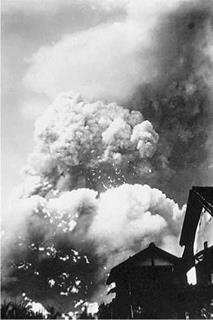
Atomic bomb cloud begins to mushroom over Hiroshima on August 6, 1945, just two minutes after the explosion. This attack, plus the subsequent bombing ofNagasaki a few days later, prompted the Japanese government to surrender unconditionally. (Corel)
|
On Iwo Jima, the XX Air Force commits 100 P-51 Mustangs to strike targets in and around Tokyo, Japan.
Over Japan, Far East Air Forces (FEAF) aircraft strike targets in Kyushu, and the southern Korean coast; they continue doing so until the end of hostilities.
AUGUST 7 Over Japan, as XX Air Force B-29s strike industrial targets in Kyushu, they are escorted by new, long-range P – 47N fighters of the Far East Air Forces (FEAF).
AUGUST 8 In Virginia, scientists working at the NACA Langley Memorial Aeronautical Library publish an essay suggesting that an aircraft powered by atomic engines may one day be able to circumnavigate the globe several times without landing to refuel. Incredibly, they predict it would be powered by a fuel source no larger than a brick.
Over Japan, the combined wrath ofFar East Air Forces (FEAF) and the XX Air Force is unleashed against the Nippon Oil Refinery in Kyushu, while a further 60 B-29s hit targets that evening in Tokyo and Fukuyama.
AUGUST 9 To force Japan’s surrender and spare that nation, and the United States, the prospect of a horrifically costly conventional invasion, President Harry S. Truman orders a second atomic bomb dropped on Kokura. However, cloud cover forces the B-29 bomber Bock’s Car under Major Charles W. Sweeney to drop the “Fat Man” weapon against Nagasaki, which kills 35,000 people and devastates the city. Unlike the previous mission, Sweeney is plagued by technical glitches like a faulty fuel pump that force him to make an emergency landing on Okinawa.
Over Japan, 95 B-29 heavy bombers are dispatched by the XX Air Force
to strike the Nippon Oil Refinery near Amagasaki. During this mission the Superfortesses are armed with 20,648 pounds of bombs and incendiaries apiece.
AUGUST 10 In China, command of the Fourteenth Air Force passes from Major General Claire L. Chennault to Major General Charles B. Stone.
In Baltimore, Maryland, American rocket pioneer Dr. Robert H. Goddard dies. He launched the first liquid-fueled rocket back in 1926 and, while his experiments were ignored at home, the Germans were keen to incorporate his research efforts into their own.
AUGUST 12 Over China, aircraft of the Fourteenth Air Force attack Japanese troop convoys moving through the Changsha corridor.
AUGUST 13 Over Japan, six B-24s belonging to the Eleventh Air Force make that
unit’s final bomb run of the war by striking targets at Kashiwabara by radar.
August 14-15 Over Japan, the XX Air Force mounts its largest sortie ever—754 bombers and 169 fighters—on a final wave of bombing raids against the Japanese mainland. Targets at Hikari and Osaka are struck. The P-51s complete their mission by attacking airfields en route to returning to Iwo Jima. That night 160 B-29s make the final incendiary raid of the war by attacking Kumagaya and Isezaki. A smaller sortie from the Marianas to Tsuchizakiminato covers 3,650 miles round-trip—the longest such mission of the entire war. Before the bombers can return to base, President Harry S. Truman announces Japan’s unconditional surrender.
AUGUST 15 In Tokyo, Japan, Emperor Hirohito takes to the airwaves and orders his countrymen to surrender. The Japanese people are stunned by this, but
unhesitatingly obey. Meanwhile, General Douglas MacArthur is appointed supreme commander of all United Nations powers, and all offensive actions against Japan are ordered to halt.
AUGUST 18 Over Tokyo, Japan, a pair of B-32 Dominators commits the final American reconnaissance mission of the war. They are attacked by Japanese fighters, which kill one American and wound two others while losing two aircraft to bomber defenses. This is also the final aerial combat mission of World War II.
AUGUST 27 Over China, B-29s of the XX Air Force begin airdropping supplies to prisoners ofwar in the Weihsien camp near Beijing. Ultimately, 4,470 tons of food and supplies are delivered to 154 camps and the 63,500 inmates housed.
AUGUST 29 Over Korea, a B-29 bomber delivering supplies to prisoners is attacked by Soviet fighters and shot down; this is the first brush with the Red Air Force.
August 30-September 11 In Tokyo, Japan, Mission 75 commences as C-54 transport aircraft arrive and deliver the 11th Airborne Division, the 27th Infantry Division, and advanced echelons from General Douglas MacArthur’s headquarters. They fly a total of 1,336 missions without a single mishap.
September In Washington, D. C., the Bell XP-59, America’s first jet fighter, arrives at the Smithsonian Institution for exhibition purposes. Today it resides at the National Air and Space Museum’s Milestones of Flight gallery.
September 3 In Japan, film and photos taken of the surrender ceremony in
Tokyo are placed onboard a C-54 Skymaster, which promptly arrives in Washington, D. C., a record 31 hours and 25 minutes later. Ironically, due to crossing the international dateline en route, the flight starts and finishes on the same calendar day!
September 4 Near Hokkaido, Japan, Soviet fighters intercept two Eleventh Air Force B-29s as they conduct a high – altitude reconnaissance mission of Para – mushiru and Shimushu.
SEPTEMBER 5 Over Santa Monica, California, the Douglas XC-74 prototype flies for the first time. This huge, four – engined transport enters service as the Globemaster.
SEPTEMBER 26 At the White Sands Range, New Mexico, the U. S. Army fires its first liquid-propelled rocket, the WAC Corporal, which reaches an altitude of 43.5 miles. This device is a copy of the German V-2.
SEPTEMBER 15 The U. S. Army Air Forces obtains its 1,391st JB-2 Loon guided rocket, after which production ceases.
September 29 Project paperclip continues as German scientist Dr. Wernher von Braun and his scientific consorts arrive in the United States to assist in the American missile and space program.
OCTOBER 4 In Washington, D. C., an Army Air Forces C-54 Skymaster completes the first global flight for an aircraft of its kind by covering 23,279 miles in 149 hours and 44 minutes. This includes 33 hours and 21 minutes on the ground to refuel at various places.
OCTOBER 11 At the White Sands Proving Ground, New Mexico, a Tiny Tim rocket, the first liquid-fueled rocket of American origin, is fitted to the nose of a WAC (without altitude control) Corporal and fired, reaching an altitude of 43 miles.
OCTOBER 13 At Wright Field, Dayton, Ohio, the Army Air Forces sponsors a large open house to display American and captured aircraft to the public. The display draws one million visitors over the following week.
OCTOBER 20 In Washington, D. C., a flight of three B-29 bombers led by Lieutenant General Nathan F. Twining lands, having covered 13,000 miles from Guam in only 60 hours. There were refueling stops in India and Germany.
NOVEMBER 7 The Bell Aircraft Corporation flies a remote-controlled version of its P-59 jet fighter. A cockpit television camera projects instrument panel readings to a ground station.
November 19-20 In Washington, D. C., the B-29 bomber Pacusan Dreamboat piloted by Lieutenant Colonel G. R. Stanley completes a record 7,196-mile nonstop flight from Guam in only 35 hours.
NOVEMBER 25 From Savannah, Georgia, a Douglas A-26 Invader flown by Colonel Joseph Holzapple flies around the world in only 96 hours, 50 minutes of flying time, then lands in Washington, D. C.
November 29 At Maxwell, Alabama, the Army Air Forces School permanently relocates from Orlando, Florida. This institution becomes a major command and is the present-day site of the Air University.
December 3 At March Field, California, the 412th Fighter Group is the first
American unit equipped with new Lockheed P-80A Shooting Star jetfighters.
December 8 The ubiquitous, glass – domed Bell Model 47 becomes the first CAA-certified helicopter to fly commercially in the United States. It sees widespread civilian and military applications over the next three decades.
At Washington, D. C., the Douglas XB-42 Mixmaster flown by Lieutenant Colonel H. F. Warden and Captain Glenn W. Edwards arrives from Los Angeles, California, after a record transcontinental flight offive hours, 17 minutes, and 55 seconds. Though this was a propeller – pusher design, the XB-42 averages 433.6 miles per hour in flight.
DECEMBER 11 In New York, the B-29 Pacusan Dreamboat piloted by Colonel Clarence S. Irvine arrives from Burbank, California, having covered the 2,464- mile distance in a record 5 hours, 27 minutes, and 8 seconds. Its average speed was 450.38 miles per hour, a record for multiengine aircraft.
December 14 The Bell Aircraft Company contracts with the Army Air Forces to construct three swept-wing, supersonic research aircraft; the three aircraft eventually emerge as the X-2.
December 17 In Washington, D. C., General Carl A. Spaatz receives the Collier Trophy from President Harry S. Truman for successfully directing the air war in Europe.
December 30 The Republic XF-12 Rainbow reconnaissance aircraft makes its maiden flight. This well-stocked flying photo laboratory carries five crewmen at 425 miles per hour, but the Army Training Support Center subsequently cancels its order for six additional aircraft.
1946
JANUARY 10 Over Stratford, Connecticut, a Sikorsky R-5 helicopter piloted by C. A. Moeller and D. D. Viner sets an unofficial world helicopter altitude record of 21,000 feet.
JANUARY 16 The U. S. government institutes the Upper Atmospheric Research panel for the purpose oftesting and evaluating 60 captured German V-2 rockets. Their work inspires similar rocket programs at Johns Hopkins University, Maryland, and the Naval Research Laboratory.
JANUARY 19 Over Pinecastle Army Air Base, Florida, the Bell XS-1 rocket – powered research plane completes its first successful glide test with Jack Woolams at the controls.
JANUARY 26 At Eglin Field, Florida, the First Experimental Guided Missile Group is assembled to test and develop rocket propulsion technology.
A Lockheed P-80 Shooting Star piloted by Colonel William H. Councill completes a transcontinental flight in only 4 hours and 13 minutes. His plane averages 584 miles per hour.
FEBRUARY 3 The Army Air Forces reveals plans to develop a totally automatic flight profile system, whereby the onboard pilot will only be required to monitor controls in flight.
FEBRUARY 4 Lieutenant General James H. “Jimmy” Doolittle is installed as the first president of the new Air Force Association. This civilian organization exists to help promote aerospace power to the public, along with the strategic role it plays in national defense.
FEBRUARY 9 Command of the Army Air Forces (AAF) passes from General of the Army Henry H. Arnold to General Carl A. Spaatz, who formally assumes office as of March 1.
FEBRUARY 26 At Honington Air Station, Suffolk, England, the Army Air Forces officially closes the last of its 112 World War II-era bases. However, a snowstorm prevents the departure of the last remaining B-17 heavy bomber.
February 28 The Republic XP-84 prototype flies for the first time with Major William Lien at the controls. As the Thunderjet, it becomes the first postwar jetfighter acquired by the Army Air Forces (AAF).
MARCH In Los Angeles, California, the new Project RAND is established in conjunction with the Douglas Aircraft Company to investigate the possibilities and potential uses of rockets, satellites, and supersonic aviation.
In light of the real hazard posed to the United States by V-2-type weapons, the Army Air Forces announces a new program to develop a ballistic missile defense system.
MARCH 8 The glass-domed Bell Model 47 becomes the first helicopter certified for flight by the Civil Aeronautic Agency. This mainstay of military aviation enters service as the UH-13.
MARCH 11 An early afterburner is tested at simulated high altitudes by the NACA Lewis Altitude Wind Tunnel.
MARCH 12 At Maxwell Field, Alabama, the new Air University replaces the Army
Air Forces School. As such it enjoys jurisdiction over the Air Command and Staff School, the Air War College, and bases offering support and training functions.
MARCH 15 At the White Sands Proving Ground, New Mexico, the Army Air Forces test fires a captured German V-2 rocket in static mode for the first time.
MARCH 21 The Army Air Forces activates three new organizations: the Air Defense Command (ADC), the Strategic Air Command (SAC), and the Tactical Air Command (TAC).
MARCH 22 A WAC rocket is the first American projectile to penetrate the Earth’s atmosphere as it reaches an altitude of 50 miles. The device was a collaboration between Army Ordnance and the Jet Propulsion Laboratory.
APRIL 1 In Buffalo, New York, the Bell Corporation signs a few postwar missile contracts to develop Project MX-776, a guided tactical missile capable of hitting targets at distances of 100 miles. This is eventually known as the Rascal missile.
APRIL 16 At the White Sands Proving Ground, New Mexico, the Army Air Forces launches a German V-2 rocket for the first time. The United States is slowly entering the Space Age with captured enemy equipment and technology.
April 19 In San Diego, California, the Consolidated Vultee Company contracts with the Army Air Forces to develop the first intercontinental ballistic missile (ICBM). This project goes under the name MX-774.
April 22 In Maryland, the Glenn L. Martin Company signs a contract to construct a surface-to-surface guided missile with a 600-mile range. This is the genesis of the Matador missile, or MX-771.
It is announced that the U. S. Weather Bureau is teaming up with the Army Air Forces, Navy, NACA, and several universities to collect data for a better understanding of weather and related phenomena. Among the devices employed are pilotless P-61 aircraft and manned gliders.
MAY 16 At Wright Field, Ohio, the Army Air Forces Institute of Technology is founded and is intended to graduate 350 officers annually after advanced studies.
May 17 In Los Angeles, California, the Douglas XB-43 becomes the first jet – powered American bomber to fly. This twin jet design, while impressive, does not go into production.
MAY 28 The Army Air Forces initiates Project NEPA to investigate the potential for atomic energy as a means of aircraft propulsion; work continues over the next decade.
May 29 In Washington, D. C., the War Department Equipment Board reports that tactical missiles and rockets will play an important role in future armed combat. They also recommend the development of no less than seven new systems, including surface-to-surface projectiles with ranges up to several thousand miles.
June 3 A Lockheed P-80 Shooting Star flown by Lieutenant Henry A. Johnson sets a world speed record over a 1,000- kilometer course by averaging 462 miles per hour; he finishes in only 1 hour and 20 minutes.
June 5 The Army Air Forces announces that it has decided to commence construction of two new multiengine jet bombers, the North American XB-45 and the Boeing XB-47.
June 17 In Washington, D. C., Professor Theodore von Karman is appointed the first chair of the new Scientific Advisory Board (SAB) created at the Pentagon. This forms from the original 33 scientists and engineers cobbled together for Operation lusty, then tasked with acquiring secret German technology at the end of World War II. It remains in active service to present times.
June 22 Two P-80 Shooting Stars take off from Schenectady, New York, with one proceeding to Washington, D. C., and the other to Chicago, Illinois. This act initiates the world’s first jet-powered airmail delivery.
June 26 The Army Air Forces and the Navy both adopt the knot (one nautical mile per hour) and the nautical mile
|
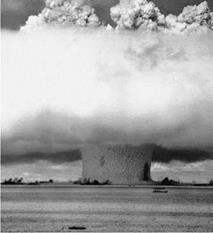
Atomic bomb explodes during the “Baker Day” test at Bikini Atoll in the Marshall Islands on July 25, 1946. This ground level image was taken about six seconds after detonation. The advent of nuclear weapons wielded an indelible impact on subsequent military strategy and tactics. (Naval Historical Center)
|
(1.15 of a statute mile) as standard units of measurement for speed and distance.
June 28 In Seattle, Washington, the Boeing Company contracts with the Army Air Forces to design and develop a new generation of heavy jet bombers; it ultimately emerges as the B-52 Stratofortess.
July 1 At Bikini Atoll in the Pacific, Operation crossroads unfolds as a B-29 christened Dave’s Dream drops a Fat Man-type atomic bomb over an armada of 73 anchored test vessels. The bomb is offtarget yet still manages to sink five vessels and heavily damage nine more. Much valuable information is gathered following the detonation.
July 25 At Bikini Atoll in the Pacific, Operation crossroads continues as a second atomic bomb is detonated 90 feet below the ocean surface; the ensuing blast sinks eight more ships and causes considerable radioactive contamination.
AUGUST 6 At Muroc Dry Lake, California, two remote-controlled B-17s successfully complete a flight that originated at Hilo, Hawaii.
AUGUST 8 At Fort Worth, Texas, the massive six-engine XB-36 prototype, which has been under development since 1941, flies for the first time. Thus huge craft enters service as the B-36 Peacekeeper.
AUGUST 12 In Washington, D. C., President Harry s. Truman signs legislation establishing the National Air Museum at the smithsonian Institution. This remains the most visited museum in the world, with 100 million guests annually.
AUGUST 17 Over Ohio, Sergeant Larry Lambert becomes the first American to utilize an ejection seat after he vaults from a P-61 Black Widow and survives. At the time he was traveling 302 miles per hour at an altitude of 7,800 feet.
AUGUST 31 A Lockheed P-80 Shooting Star flown by Colonel Leon Gray wins the Jet Division of the first postwar Bendix Cup Race by flying from Los Angeles, California, to Cleveland, Ohio, in 4 hours and 8 minutes while averaging 495 miles per hour.
SEPTEMBER 30 At Muroc Field, California, the NACA Muroc Flight Test Unit arrives from Langley Laboratory to assist development of the Bell XS-1 program. This detachment consists of 13 scientists under the direction of Walter Williams. Ironically, friction arises between the scientists and the Army Air Forces over which group will be responsible for achieving supersonic flight. Nonetheless, they constitute the origins for the future NASA Flight Research Center at present-day Edwards Air Force Base.
October 4—6 A B-29 christened Pacu – san Dreamboat, piloted by Colonel C. S. Irvine, completes the first nonstop flight over the North Pole. Irvine’s flight takes him from Hawaii, over the pole, to his final destination in Egypt, having covered
10,0 miles in 40 hours of flight time.
OCTOBER 7 In Buffalo, New York, the first Bell XS-1 rocket plane is shipped off to Muroc Dry Lake, California, for flight – tests. A total of three are constructed, although they subsequently receive the more famous designation X-1.
October 10 At White Sands Proving Ground, New Mexico, space science begins once a V-2 rocket goes aloft carrying specialized equipment for taking spectroscopic readings of the upper atmosphere.
October 25 At White Sands Proving Ground, New Mexico, a DeVry 35mm camera fitted to a V-2 rocket is carried to an altitude of 65 miles to make the first film records of planet Earth from that height. At its apogee, the camera captures an area of 40,000 square miles.
DECEMBER 8 Over Muroc Dry Lake, California, the first Bell XS-1, piloted by Chalmers Goodlin, is successfully dropped by a B-29 carrier aircraft, ignites its rocket motors, then flies up to 35,000 feet and Mach 0.75.
December 17 At Holloman Air Force Base, New Mexico, the National Institute of Health creates a space biology research program, which includes a high-speed rocket sled to study the effects of high-G (gravity) situations on human beings.
At the White Sands Proving Ground, New Mexico, a V-2 rocket reaches 166 miles in height and a speed of 3,600 miles per hour, both world records for a single-stage rocket. The device also carries fungus spore samples into space to test their reaction to cosmic rays.













